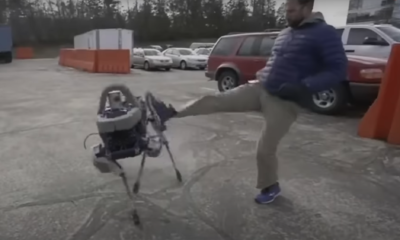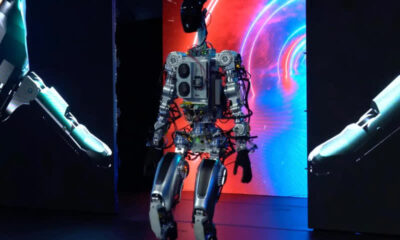Gadgets
Dog robots can trek through mud using moose-inspired hooves

Many quadrupedal robots can navigate uneven or sloped terrain effectively, but struggle in slippery or muddy conditions. However, a team of engineers has discovered a solution inspired by animals that thrive in boggy environments. A study published in Bioinspiration & Biomimetics by researchers at Tallinn University of Technology (TalTech) in Estonia suggests that robots could learn from the abilities of giant moose.
[Related: Why animals run faster than their robot counterparts… for now.]
According to TalTech biorobotics professor Maarja Kruusmaa, “Most robots struggle to operate in important terrestrial environments such as wetlands, bogs, coastal marshes, and fields, which are common in nature.”
Ungulates like cattle and moose have evolved to thrive in these challenging conditions. Researchers studying moose feet found that their cloven hooves are essential for navigating through mud and waterlogged terrain. The ability of split hooves to spread out and contract with each step allows moose to avoid sinking too deeply into the mud. Additionally, the cloven hooves possess suction properties that help moose break free from sticky surfaces.
Simon Godon, a biorobotics doctoral candidate and study co-author, explained, “The moose’s hoof acts like a suction cup, allowing it to break free from sticky surfaces.” This unique property enables moose to navigate muddy terrain effectively.
Godon compared the properties of mud to wet bathroom tile sticking to your feet, emphasizing that moose hooves are designed to prevent them from getting stuck. Inspired by their findings, researchers developed silicone slippers for quadrupedal robots. These moose-inspired booties reduced sinkage depth by 46% and decreased suction force by a similar percentage. Additionally, the accessories lowered the energy cost of walking for the robots by up to 70%.
[Related: Casio introduces an AI-powered furball as a potential pet replacement.]
The engineers then tested a quadruped robot fitted with moose-inspired feet in the Estonian woods, observing a 38% reduction in mechanical transport cost and a 55% increase in speed. The team noted that the redesigned feet did not have any negative impact on hard ground surfaces.
The study concluded that redesigning the feet of quadruped robots can enhance their versatility and efficiency on various terrains. With these simple silicone alterations, future robots could access previously inaccessible environments for tasks such as land surveys, security, and rescue operations.
Please rewrite this sentence.
-

 Destination3 months ago
Destination3 months agoSingapore Airlines CEO set to join board of Air India, BA News, BA
-

 Tech News7 months ago
Tech News7 months agoBangladeshi police agents accused of selling citizens’ personal information on Telegram
-

 Motivation7 months ago
Motivation7 months agoThe Top 20 Motivational Instagram Accounts to Follow (2024)
-

 Guides & Tips6 months ago
Guides & Tips6 months agoSatisfy Your Meat and BBQ Cravings While in Texas
-

 Guides & Tips5 months ago
Guides & Tips5 months agoHave Unlimited Korean Food at MANY Unlimited Topokki!
-

 Gaming5 months ago
Gaming5 months agoThe Criterion Collection announces November 2024 releases, Seven Samurai 4K and more
-

 Tech News6 months ago
Tech News6 months agoSoccer team’s drone at center of Paris Olympics spying scandal
-

 Self Development7 months ago
Self Development7 months agoDon’t Waste Your Time in Anger, Regrets, Worries and Grudges
























